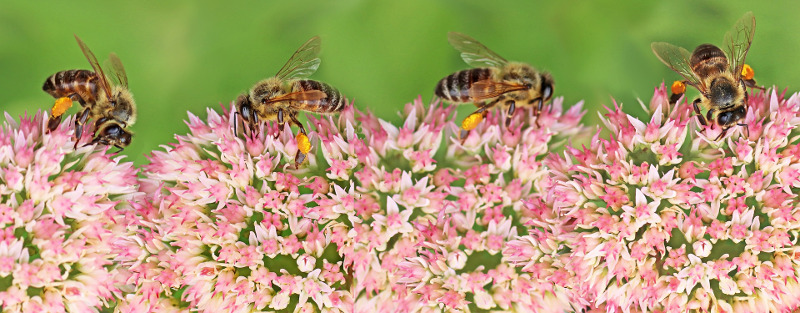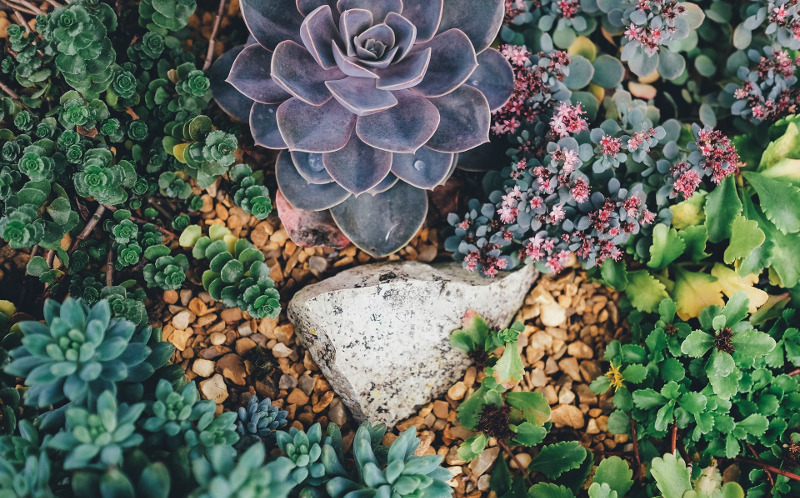Sedum is a very hardy and tough plant that is cold hardy to many different growing zones in the United States, ranging from zone 3 to zone 11. Growing stonecrop sedum is becoming more and more popular due to how easy the plants are to grow, the different varieties to choose from, the beautiful flowers the plants produce, and the fact that they are great for wildlife!

Stonecrop sedum is a perennial typically hardy to zones 3 to 9. The plants have thick and fleshy leaves and foliage, and typically bloom in late summer and fall. Butterflies and bees both love the flowers and will usually be covered in the pollinating insects during the entire blooming season.
Click on each link to read more in depth information on each topic. The information on this page just touches the surface and provides general care information for growing sedum successfully.
Planting Sedum
Sedum plants need a location with soil that is very well drained and with at least 6 hours of direct sunlight. Beyond that, there isn’t really much else that you need to do for the plants in order for them to thrive.
Watering Sedum
Unless you are going through a long period of drought, you won’t need to provide additional water. During dry periods, the plants can be watered around once per week, given the soil completely dries out between watering. It's typically best to under-water than over-water.

Fertilizing Sedum
At most you should fertilize every other year. But you can also just let the plants grow without providing additional nutrients. An easy way to ensure you don’t over-fertilize is by providing mulch or organic compost each year to help the soil. Just make sure the soil still drains properly.
Pruning Sedum
Sedum can be cut back and divided throughout the year to help ensure the plants have enough space to grow and are looking the best they can. But pruning and trimming is not required for the plants to be healthy.

Sedum Winter Care
Make sure you are growing a plant hardy in your growing zone, and make sure the soil drains. This is especially important during times when there is a lot of snow and ice on the ground. You can add additional protection by adding some mulch around the plants too.
Growing Sedum in Pots
Garden planters and other containers are great locations for sedum, given the pots have proper drainage. The plants may require more water than if planted in the ground as planters tend to dry up faster.

Common Questions About Sedum
Are Sedum Deer Resistant?
Typically deer will not prefer to eat sedum.
Are Sedum Poisonous?
No, sedums are not poisonous.
Why Aren’t My Sedum Blooming?
There are several reasons why your plants aren’t blooming. The most common reason is not getting enough sunlight.
What Is The Growth Rate Of Sedum?
Different sedums grow at different rates, and how quickly they grow also depends on soil quality, watering, feeding, climate, etc. That said, they are generally considered to be slow-growing plants.
Does Sedum Spread Quickly?
Some ground cover sedums can grow up to one inch a month during the growing season, quickly filling in.
Why Does My Sedum Fall Over?
Sedums prefer sandy, well-drained soil, and lots of suns. If they're falling over, it may be from rich, soggy soil, and not enough sunlight.
What Is The Sedum Height?
Ground cover sedums stay low to the ground and spread a few feet in each direction and clumping sedums can reach between 1 and 3 feet tall.
Is Sedum Annual Or Perennial?
Sedums are perennials, coming back each year, and as a bonus, bees and butterflies are very fond of them!
Why Does Sedum Leave Turning Brown?
The leaves on a sedum may be turning brown due to powdery mildew or Botrytis. Powdery mildew can be mitigated by the application of neem oil, and Botrytis can be fought with sulfur or copper-based fungicide.
Have a question about Sedum? Fill out the form below and we will try and get back to your question as soon as possible. We may even feature your question in this article to help other gardeners!
 |
Author Chris Link - Published 1-28-2021 |
